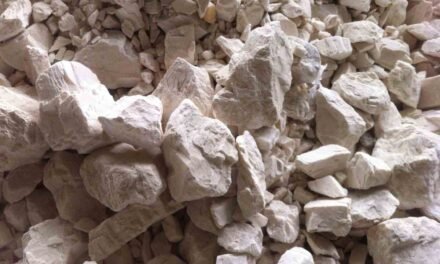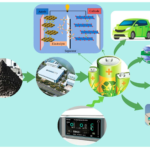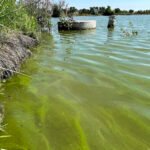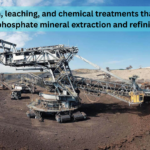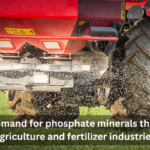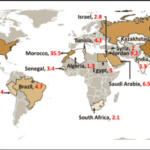Phosphate mining, while essential for producing fertilizers that support global agriculture, comes with several environmental challenges. These challenges can have long-lasting effects on ecosystems, water quality, and human health if not properly managed. However, through careful planning, technology, and regulatory frameworks, many of these issues can be mitigated.
Here’s a detailed look at the main environmental challenges associated with phosphate mining and potential mitigation strategies:
1. Water Pollution and Contamination
Challenges:
- Runoff from mining operations can carry toxic chemicals, phosphate dust, and heavy metals into surrounding water bodies, leading to contamination of rivers, lakes, and groundwater.
- Acid mine drainage (AMD) can occur when phosphate ore contains sulfide minerals, leading to the formation of sulfuric acid when exposed to air and water. This acid can leach out harmful metals (e.g., arsenic, cadmium, lead) into water sources, severely affecting aquatic life and water quality.
- Wastewater generated during beneficiation (e.g., tailings and slurry), if improperly managed, can also lead to contamination.
Mitigation Strategies:
- Water Treatment and Recycling: Implement advanced water treatment technologies (e.g., reverse osmosis, flocculation) to purify contaminated water and reduce the discharge of harmful substances. Recycling water within the mining operation can also reduce the demand for freshwater and minimize runoff.
- Containment of Tailings: Design tailings ponds or dry stacking systems to contain the waste and prevent it from leaching into nearby water bodies. Proper lining and regular monitoring of these containment systems are essential.
- Neutralization of Acid: When acid mine drainage is a risk, neutralizing agents such as lime can be added to neutralize the acidic water before it reaches natural water systems.
- Constructed Wetlands: In some cases, creating constructed wetlands around mining areas can help filter out pollutants and improve water quality.
2. Habitat Destruction and Land Degradation
Challenges:
- Land clearing for phosphate mining can lead to the destruction of local ecosystems, including forests, wetlands, and grasslands. This disrupts wildlife habitats, leading to loss of biodiversity.
- Erosion and soil degradation can result from mining activities, especially when topsoil is removed and vegetation is disturbed.
Mitigation Strategies:
- Sustainable Land Management: Implement reclamation plans that restore mined lands to their original state or transform them into usable post-mining landscapes (e.g., forests, grasslands, agricultural land).
- Progressive Reclamation: Adopt progressive reclamation practices, where land is restored during the mining process itself, not just after mining is completed. This helps to reduce the long-term impact and allows the land to begin recovery sooner.
- Minimize Land Clearing: Use modern mining techniques that reduce the footprint of mining operations and minimize land disturbance. For example, underground mining methods, when feasible, can help avoid significant surface land degradation.
- Buffer Zones: Establish buffer zones around critical ecosystems and water bodies to reduce the impact of mining activities on local wildlife and prevent habitat destruction.
3. Air Pollution and Dust Generation
Challenges:
- Dust generated during the mining, crushing, and transportation of phosphate rock can degrade air quality, leading to health issues for workers and nearby communities. Fine phosphate dust can also spread over large areas, affecting vegetation and ecosystems.
- Emissions from mining machinery and processing plants can contribute to air pollution, including particulate matter and greenhouse gases.
Mitigation Strategies:
- Dust Control Measures: Implement effective dust suppression systems such as water sprays, dust collectors, and chemical suppressants to minimize dust generation during mining operations.
- Enclosed Processing Plants: Use enclosed systems or ventilated processing plants to reduce the release of dust and other particulate matter into the air.
- Green Belts and Vegetation: Establish green belts or vegetative cover around mining sites to trap dust and provide natural filtration.
- Alternative Energy Sources: Transition to cleaner energy sources for mining operations, such as solar, wind, or bioenergy, to reduce air emissions from fossil fuel-based machinery.
4. Greenhouse Gas Emissions
Challenges:
- Phosphate mining and its associated processes, especially acid production (e.g., sulfuric acid), emit greenhouse gases (GHGs), including carbon dioxide (CO₂), nitrous oxide (N₂O), and methane (CH₄).
- The transportation of phosphate rock and the processing of phosphates into fertilizers also contribute to GHG emissions.
Mitigation Strategies:
- Energy Efficiency Improvements: Implement more energy-efficient technologies for phosphate mining, processing, and transportation to reduce the carbon footprint. This can include optimizing equipment performance, improving heat recovery systems, and using more efficient machines.
- Carbon Capture and Storage (CCS): If feasible, employ carbon capture technologies in processing plants to capture and store CO₂ emissions.
- Use of Renewable Energy: Invest in renewable energy sources such as solar or wind power for mining operations to reduce reliance on fossil fuels and decrease GHG emissions.
- GHG Monitoring and Reporting: Implement robust systems for monitoring and reporting GHG emissions from mining and processing operations, and set targets for emissions reduction.
5. Heavy Metal Contamination
Challenges:
- Heavy metals like arsenic, cadmium, mercury, and lead can be present in phosphate ore or introduced into the environment through mining waste. These metals can contaminate soil and water, posing serious risks to both ecosystems and human health.
- Bioaccumulation of heavy metals in plants and animals can lead to toxic effects further up the food chain.
Mitigation Strategies:
- Monitoring and Regulation: Establish strict environmental regulations and monitoring programs for heavy metal concentrations in mining effluents, water bodies, and soil around phosphate mines.
- Recycling and Waste Management: Use advanced recycling techniques to reduce the amount of heavy metal waste produced. Waste stabilization and treatment methods can help lock up heavy metals in solid forms to prevent leaching.
- Use of Biofilters: Phyto-remediation (the use of plants to remove toxins) can be employed in some cases to reduce heavy metal contamination in soil or water.
6. Radioactive Contamination
Challenges:
- Some phosphate ores contain trace amounts of radioactive elements, such as uranium and thorium. These elements can be released into the environment during mining and processing, leading to radioactive contamination of surrounding areas.
- Radon gas, a byproduct of uranium decay, can also pose a health risk to workers and nearby communities.
Mitigation Strategies:
- Radiation Monitoring: Regularly monitor radioactive emissions and contamination levels in and around phosphate mines to ensure they stay within acceptable limits.
- Waste Management: Properly store and contain radioactive waste from phosphate mining in secure, well-managed disposal sites to prevent environmental contamination.
- Technological Solutions: Invest in research and development of technologies to reduce the release of radioactive elements during phosphate processing, such as radiation removal or capture methods.
7. Social and Health Impacts
Challenges:
- Health risks to local communities and workers due to exposure to hazardous chemicals, dust, and noise.
- Displacement of communities or disruptions to local livelihoods (e.g., agriculture or fishing) due to mining operations.
Mitigation Strategies:
- Community Engagement: Involve local communities in the decision-making process, addressing concerns and ensuring that mining projects provide social and economic benefits such as jobs and infrastructure improvements.
- Health and Safety Programs: Implement robust occupational health and safety measures to protect workers from exposure to dust, chemicals, and other mining-related hazards.
- Sustainable Development Initiatives: Foster sustainable economic growth in nearby communities by investing in education, healthcare, and infrastructure as part of the mining project.
Conclusion
Phosphate mining presents significant environmental challenges, including water pollution, habitat destruction, air pollution, and heavy metal contamination. However, these challenges can be mitigated through advanced technologies, careful land management, and strong regulatory frameworks. Solutions like water treatment systems, progressive reclamation, dust control measures, and carbon reduction strategies can help reduce the environmental footprint of phosphate mining operations. By implementing these best practices, the phosphate mining industry can contribute to global agricultural needs while minimizing its impact on the environment.
Hashtag
#PhosphateMining #EnvironmentalImpact #MiningPollution #SustainableMining #PhosphateExtraction #WaterContamination #MiningWasteManagement #SoilDegradation #EcoMining #PhosphatePollution #GreenMining #MiningReclamation #MiningMitigation #PhosphateWaste #MiningSustainability #AcidMineDrainage #PhosphateEcoSolutions #EnvironmentalRisks #PollutionControl #ResponsibleMining




